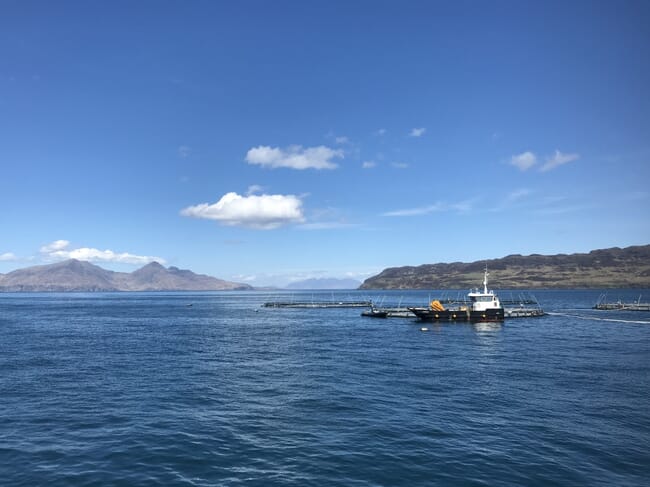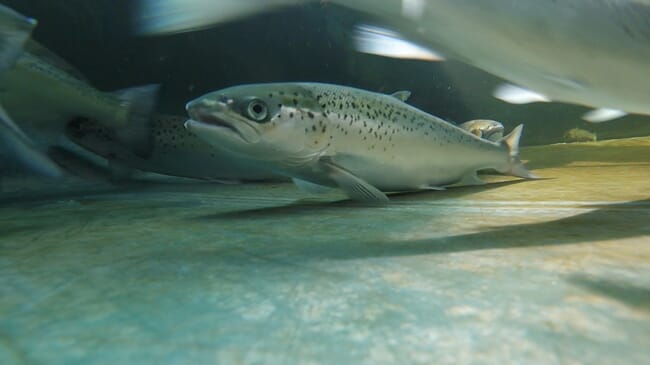As we approach midsummer and the sea temperature rises, a number of subtle changes are taking place in Scotland’s west coast waters: more plankton in the water column, more seaweed growth and the return of warm-weather species.

Whilst none of this might sound significant, it does affect things on site. The nets need to be cleaned more regularly, we must be vigilant for jellyfish, as these can have negative impacts on gill health, and we have fitted an aeration system across the fish farm as a precautionary measure against algal blooms.
However, watching these natural environmental changes unfold on a daily basis is a privilege that many do not have. This small, seasonal increase in temperature has the power to transform the environment around us. Witnessing it first-hand has reinforced my impression of how diverse and productive, yet sensitive, our marine environment is.
A UN report was recently released, warning us of unprecedented levels of species loss globally. A million plant and animal species are now threatened with extinction – largely due to us, the human race. In Scotland, we are all too aware of the declining wild Atlantic salmon population, which has also received its fair share of media coverage lately.
Having been brought up by lovers of fly fishing on the River Tay, I personally find the declining wild salmon dilemma very concerning. But what I also find concerning is that many people are placing the blame for their decline solely on fish farming. I am concerned about this for two reasons. One, because there is little scientific evidence to support this. And two, because I believe the decline of our wild salmon is in fact the result of numerous contributing factors – and thus for any successful solutions to be found, these diverse causes must be acknowledged and understood.

I’m certainly no expert when it comes to wild salmon population dynamics but I do my best to keep myself informed about all sides of the discussion. As employees of an industry often at the heart of the wild salmon debate, I think we have a duty and responsibility to do so. So this month I wanted to share some of what I have found in the hope of presenting a more balanced and considered look at the wild salmon problem – a problem that is not exclusive to Scotland, but, sadly, is occurring in many places around the world.
I’m reading a book at the moment called Kings of the Yukon, which depicts the author’s own journey down the Yukon River of Alaska, telling the stories of the people who live there and their relationship with the king (or Chinook) salmon. Just like Scottish wild salmon, the kings of the Yukon are disappearing. But, unlike Scotland, there are no fish farms in Alaska. So what are some of the other reasons that could be contributing to the disappearance of wild salmon, if it’s not “just” fish farms?
Predation has to be high on the list, by birds, seals and other mammals. In the UK, the introduction of the Wildlife and Countryside Act in 1981 afforded new protection to birds throughout the country. Whilst some bird populations, such as the goosander, were once controlled as part of fisheries-management practices, they have been able to breed and grow in number since 1981. The RSPB now reports up to 3,800 breeding pairs and 12,000 resident wintering goosander in the UK and the British Trust for Ornithology cites a population increase of 82 percent between 1981 and 2008.
The basis of the goosander diet? Salmon and trout. And where do we find them? Nesting along riverbanks – putting them in a prime location to hunt and eat juvenile wild Scottish salmon or smolts travelling to sea. This is just one example of a change in predator population that has undoubtedly had a negative impact on Scottish wild salmon numbers since the 1980s.
Manmade structures, such as dams, weirs, hydroelectric schemes and culverts create obstacles and barriers to salmon migration. Over the years we have changed and utilised rivers for human benefit – to generate energy, divert water or assist with drainage. Whilst these changes might seem minimal in isolation, together they have had a cumulative impact on our Scottish river systems and the fish species that have to navigate them. The short film, The Super Salmon is a powerful reminder of how such human interference can have cascading effects throughout a river ecosystem. Although North American-based, the message is the same no matter where in the world you are.
In the catchments that surround rivers, land-use changes including the planting or cutting of commercial forestry, increases in agricultural production, mining, construction or changes to surface drainage all have an impact on the flow, levels and water quality of rivers. Related issues such as nutrient loading, flooding, run-off and pollution from surrounding land uses have become commonplace, mainly without us noticing. But I think it is safe to assume that the wild salmon have noticed.
There used to be a “three-mile limit” in Scotland, meaning that bottom trawling was not permitted within three miles of the coast. This was to maintain the rich ecosystems that support the spawning grounds of many commercial species, and thus support rich fisheries. In 1984 this three-mile limit was removed. This has not only had a direct negative impact on certain fish species but has also indirectly affected many others due to the removal and damage of kelp beds and other seaweeds – the foundation of our inshore ecosystems.
There is strong evidence to show that the removal of the three-mile limit has negatively impacted wild sea trout in Scotland. But it is just another possible contributing factor to the decline of wild salmon too, which pass through these inshore habitats at two key life-stages: on their way to sea as smolts and when returning to their birth rivers to spawn. Further out to sea wild salmon also face the risk of being caught as bycatch of pelagic fisheries, but that is a whole other issue all together…
Salmon need cold, oxygen-rich water but climate change is increasing the average temperature of our oceans. Could this be pushing wild salmon further north in pursuit of colder, more optimal waters? What impact might climate change have on the species that make up their diet, such as capelin? Much of what could or might happen is uncertain, but what is certain is that climate change is happening and it will continue to affect salmon and other species unless we do something quickly to stop or reverse the trends.
But it is not all doom and gloom and there is already some great work being done to save Scotland’s wild salmon. This year, 2019, has been declared the International Year of the Salmon and the Atlantic Salmon Trust is currently running two key projects in Scotland: The Missing Salmon Project and The Likely Suspects Framework. Using advanced tracking technology, the Atlantic Salmon Trust hopes to learn more about the life cycle of our wild salmon, where they go to and when and why they are disappearing. They hope to use this information to identify the “likely suspects” contributing to their decline and then work on solutions to rectify this.
Within the aquaculture industry, a lot is also being done to help find solutions. Launched in 2018, the Aquaculture and Wild Salmon Interactions Working Group has brought together people from Scottish government, environment agencies, salmon producers and wild-fishery boards to examine and provide advice on the interactions between wild and farmed salmon. And many salmon producers are involved in their own projects, working with wild-fishery groups to help restock salmon rivers, including Mowi’s collaboration on the River Lochy.

© Chris Conroy
There are many contributing factors as to why wild salmon numbers are declining and everyone is entitled to their own opinions on which are most responsible. But one thing that we can agree on is that, as an indicator species, the decline of our wild salmon is telling us that things are not right in our freshwater and marine environments. We humans have caused these changes and it is up to us to try and rectify the problem before it is too late.
Just as we are seeing on site at the moment, the relationship between climate, ecosystems and the species they support is powerful, yet subtle. And when you add to this the seemingly endless list of other contributing factors, it shows that our wild salmon are trying to navigate a gauntlet of man-made pressures and obstacles. None of these can be looked at in isolation; each must be seen in relation to all the others.
Pointing the finger at just one of the possible causes can’t and won’t save Scotland’s wild salmon. But I believe that further research, knowledge sharing and collaboration between all stakeholders can. And, hopefully, the projects already underway are a step in the right direction to achieve this.




